Physics of the Bird Impact Event
Initial Impact:
When a bird impacts a target plate, the particles at the front surface of the projectile (bird) are instantaneously brought to rest relative to the target face and a shock propagates into the bird as shown in frame623 in the slide. As the shock wave propagates into the bird it brings the bird material behind the shock to rest. The pressure in the shock compressed region is initially very high and is uniform across the impact Area. For the normal impact of a cylinder on a rigid plate, the flow across a shock can be considered one-dimensional, adiabatic, and irreversible.The pressure behind the shock (Hugoniot Pressure) may then be derived from the shock relation as
P=ρ*vs*v
Where,
P = Pressure behind the shock
ρ = Density of the bird
vs= Shock velocity
v = Impact velocity
The edge of the projectile is a free surface and the material near the edge is subjected to a very high stress gradient. This stress gradient causes the material to accelerate radially outward and a release wave is formed. The arrival of this release wave at the center of the bird marks the end of the initial impact and the beginning of the decay process.
Impact Pressure Decay:
Steady Flow:
As the radial pressures decrease during the shock pressure decay, shear stresses develop in the projectile material. If the shear strength of the material is sufficient to withstand these shear stresses, the radial motion of the projectile will be restricted. If, however, the shear stresses in the projectile are greater than the shear strength of the material, the material will “flow”. The shear strength of birds is so low that the pressures generated are usually sufficient to cause flow. The bird can be considered to behave as a fluid. After several reflections of the release waves, a condition of steady flow is established and steady pressure and velocity fields are established. Using potential flow theory, Wilbeck[1] calculated the steady flow pressure for a supersonic bird impact at normal incidence. He found that the pressure at the center of impact (the stagnation pressure) could be approximately given by the expression bellow frame 625 where ρ is the density of the material with zero porosity. This implies that the steady flow pressure at the center of impact is almost independent of porosity. The decrease in density due to porosity is apparently offset by the increase in compressibility.
Flow Termination:
During impact, bird material is “turned” near the target surface. As the fluid nears the target surface the velocity decreases and the local pressure increases. During steady flow a pressure field is set up in the fluid. As the end of the projectile enters this pressure field, the field is disrupted due to the intrusion of a free surface (the end of the bird). Steady flow no longer exists and the pressures at the impact surface decrease. The pressure decrease continues until the end of the projectile reaches the surface of the plate. At this time the impact event is ended.

